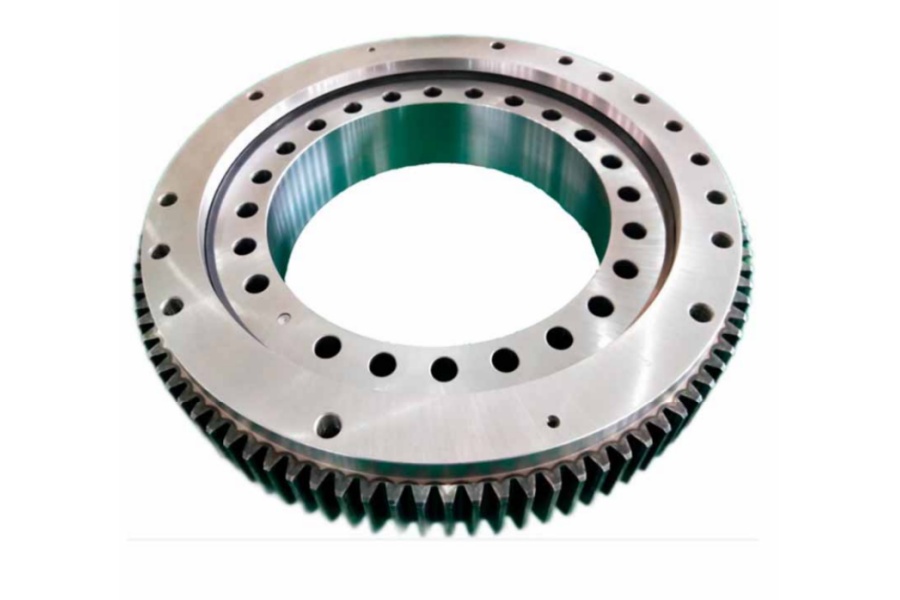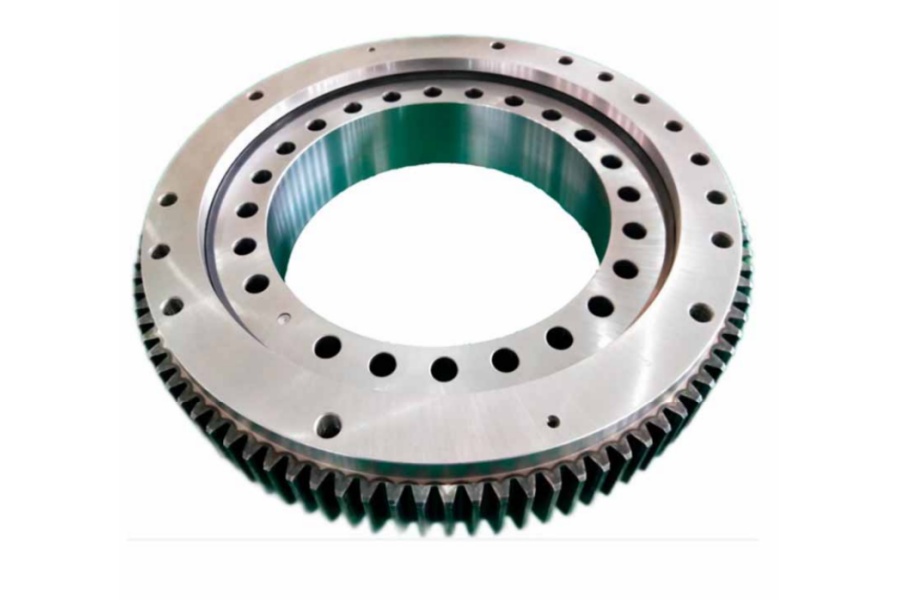
Precision Slewing Bearing Clearance Selection and Practical Application
What is Slewing Bearing
Slewing Bearing is a large-diameter rotational bearing engineered to handle combined axial, radial, and moment loads while enabling controlled rotation between structural components. Unlike conventional bearings, slewing bearings integrate mounting holes, sealing systems, and often gear teeth (internal or external) into a single unit. Their robust construction serves dual functions: supporting heavy loads and transmitting rotational motion, making them indispensable in applications requiring precise movement under extreme load conditions.

Precision Slewing Bearing Clearance Selection and Practical Application
Clearance (or preload) is a fundamental design parameter critically influencing bearing stiffness, rotational accuracy, fatigue life, and thermal behavior. Precision applications demand meticulous clearance engineering:
Clearance Ranges & Preload Classification:
Positive Clearance (0 – 0.05 mm): No preload. Allows slight internal movement, accommodating minor misalignment or structural deflection.
Zero Clearance (≤ 0 mm): Light preload. Eliminates free play for improved stiffness and positional accuracy.
Negative Clearance (-0.05 mm to -0.01 mm): Heavy preload. Creates internal compression, maximizing stiffness and minimizing elastic deformation under load.
Manufacturing Control & Verification:
Raceway Measurement: Precise dimensional metrology of raceways during machining enables calculation of theoretical clearance/preload based on component tolerances.
Post-Assembly Verification:
Positive Clearance: Directly measured using dial indicators (axial/radial play).
Zero/Negative Clearance (Preload): Quantified indirectly via Starting Torque Measurement:
A bolt is secured to the outer ring.
A peak-holding force gauge pulls perpendicularly at this bolt.
`Starting Torque (Nm) = Measured Force (N) × Bolt Hole Pitch Circle Radius (m)`
Higher starting torque indicates greater preload (smaller negative clearance).
Critical Impact of Starting Torque:
Directly determines required drive motor and gearbox specifications.
Serves as a key quality control metric for preloaded bearings.
Correlates strongly with operational smoothness and rigidity.
Application-Driven Selection Criteria:
High Precision Mandates Preload: Machine tools, medical imaging (CT/MRI), robotics, and optical systems require near-zero/negative clearance for micron-level accuracy and vibration suppression.
Structural Realities Dictate Constraints:
Preloaded bearings are highly sensitive to mounting surface flatness errors and operational deflections.
Even minor structural distortion can eliminate designed clearance/preload, causing:
Binding and erratic rotation
Dramatically increased friction and heat generation
Accelerated wear or catastrophic seizure
Applications with inherent structural flex (e.g., long booms, uneven terrain operation) often necessitate positive clearance to accommodate deflection without jamming.
Comprehensive Selection Methodology:
Define Accuracy Requirements: Quantify permissible runout and positional tolerance.
Analyze Loads & Deflections: Model operational loads and expected structural deformation (FEA recommended).
Assess Mounting Rigidity: Evaluate host structure stiffness and machining tolerances (flatness typically ≤ 0.1 mm / meter diameter).
Evaluate Thermal Environment: Preload increases with temperature rise (differential expansion).
Balance Performance vs. Risk:
Preload Advantages: Maximized stiffness, accuracy, vibration damping, longer fatigue life (under optimal conditions).
Preload Risks: Binding, overheating, drastically reduced life if conditions are imperfect.
Positive Clearance Advantages: Forgiving of installation errors/deflections, lower friction.
Positive Clearance Disadvantages: Reduced stiffness, potential for backlash/vibration under varying loads.
Key Characteristics of Slewing Bearings
Combined Load Capacity: Engineered for simultaneous axial, radial, and moment loads.
Integrated Functionality: Combines rotation, load support, and often gearing.
Precision Engineering: High-grade materials, controlled heat treatment, precision grinding.
Sealing Systems: Multi-lip seals or labyrinth designs protect internals.
Gear Integration: Optional internal/external spur or helical gears.
Mounting Flexibility: Flanged designs with bolt patterns for direct installation.
Variety: Single-row ball, double-row ball, cross roller, three-row roller configurations.
Primary Applications of Slewing Bearings
Medical Imaging: CT/MRI scanner gantries (ultra-high precision/preload).
Industrial Robotics: Robotic welding arms, precision turntables.
Machine Tools: Rotary tables, indexers.
Aerospace & Defense: Satellite antennas, radar pedestals, turret systems.
Semiconductor Manufacturing: Wafer handling stages.
Construction: Cranes, excavators (often positive clearance).
Renewable Energy: Solar trackers, wind turbine yaw/pitch drives.
Material Handling: Automated storage/retrieval systems.
Factors Influencing Slewing Bearing Price
Precision Level: Tolerances, runout control, preload requirements exponentially increase cost.
Material & Metallurgy: Aircraft-grade steels, specialized hardening (carburizing vs. induction), certifications.
Bearing Type & Size: Cross roller/three-row designs cost more than ball types; larger diameters add significant material/processing costs.
Gear Specifications: Precision ground helical gears add substantial cost vs. hobbed spur gears.
Heat Treatment Complexity: Deep case hardening for large bearings is costly and time-intensive.
Metrology & Testing: Advanced CMM inspection, 100% raceway grinding, starting torque testing, load testing (e.g., FEM 1.001).
Sealing: High-IP (e.g., IP69K) or cleanroom-compatible seals increase price.
Certifications: Medical (ISO 13485), aerospace (AS9100), DNV-GL/ABS marine approval.
Customization: Non-standard dimensions, materials, or features require engineering resources.
Quantity: Low-volume precision batches have high unit costs.
Supplier of Slewing Bearing
LYRADRIVE specializes in engineering and manufacturing high-precision slewing bearings for mission-critical applications. Their expertise encompasses advanced clearance control methodologies, utilizing rigorous starting torque measurement and custom preload optimization to achieve micron-level rotational accuracy and stiffness. LYRADRIVE focuses on collaborative design, working closely with clients to analyze structural constraints, operational loads, and environmental factors to determine the optimal clearance strategy balancing performance and reliability. Their capabilities include producing bearings with ground raceways, precision gears, and specialized sealing for sectors like medical imaging, aerospace, robotics, and advanced automation. For applications demanding exceptional rotational precision, contact LYRADRIVE to discuss clearance requirements and tailored solutions.



